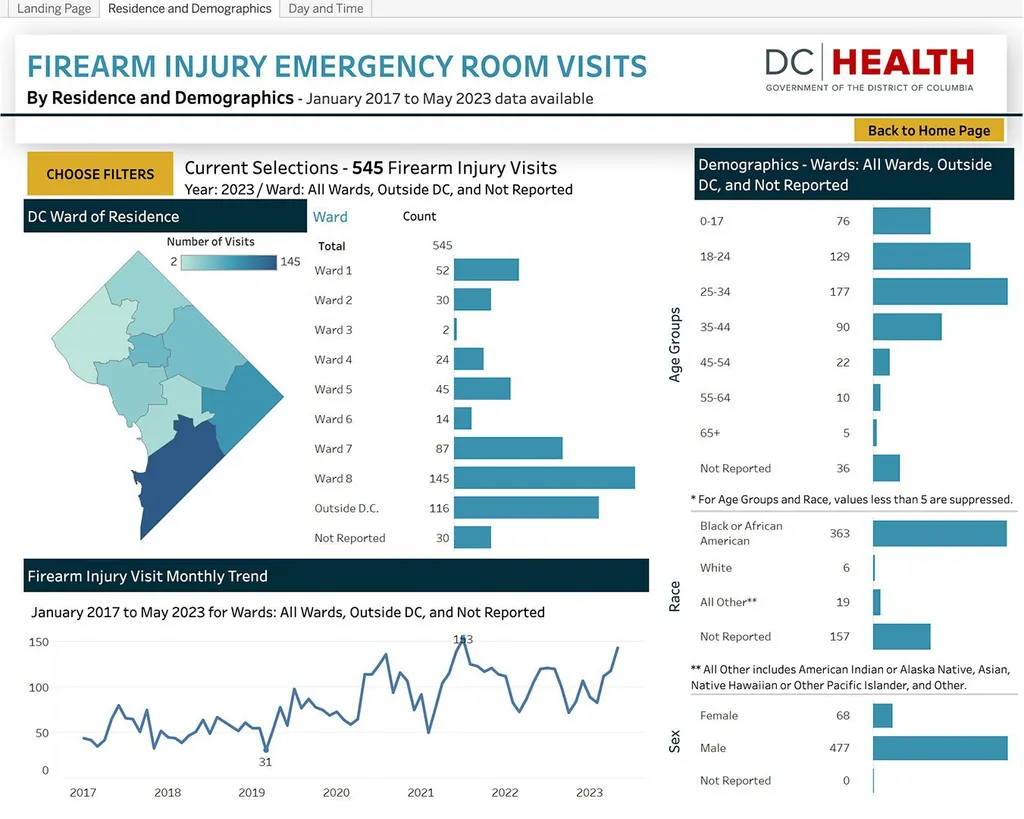- June 15, 2023
- By Allison Eatough ’97
With gunshot injuries in Washington, D.C. up nearly 20% from this time last year, a new analysis tool developed by a University of Maryland School of Public Health doctoral student is helping district leaders detect surges in gun violence, monitor at-risk groups and understand trends.
Led by Kenan Zamore Ph.D. '26, an epidemiologist with the D.C. Department of Health (DC Health), the Firearm Injury Surveillance Through Emergency Rooms (FASTER) dashboard pulls diagnostic data from D.C.’s seven hospital emergency rooms, including the age and ethnicity of victims and the ward and ZIP code where the victims live.

“We're aware of these encounters within hours of the person hitting the hospital, whereas if you wanted to query hospital data for this, it would probably be released annually,” said Zamore, who has studied patterns of disease and injury for the department for more than a decade.
The dashboard, which displays data generated when patients are admitted, discharged or transferred from an emergency room, also fills a gap in pre-existing data by including firearm injuries due to assaults as well as accidental or self-harm shootings, Zamore said. In the past, most firearm injury data came from active investigations and had a primarily law-enforcement focus.
“I think the major importance is the entrance of public health to what was traditionally considered the public safety and law enforcement sphere,” he said.
Zamore, who is studying behavioral and community health, began developing the dashboard in 2020 after DC Health received a grant from the Centers for Disease Control and Prevention. Having worked on similar dashboard projects related to the COVID-19 pandemic and opioid overdoses, he knew stakeholder input was important. Zamore met with colleagues from area hospitals and public safety agencies, who told him they wanted faster and more detailed access to demographic information about the victims.

“Data, especially when it's properly presented, helps illuminate blind spots and guides prevention,” said Zamore, adding that he hopes the dashboard helps hospitals and health agencies better deploy resources, respond proactively to problems and ultimately save more lives.
“Kenan is doing exactly what we want our doctoral students to do: working in the community to apply their skills,” said Elizabeth M. Aparicio, assistant professor with the Department of Behavioral and Community Health.
Policy and research analyst David Marimon uses the dashboard in his work for the Criminal Justice Coordinating Council, an independent D.C. agency that works with other agencies and residents to address public safety issues. FASTER helps partner agencies understand who is affected by gun violence, as well as where and when.
“Hospital-based violence intervention programs have used this data to match their staffing to peak times,” he said. “On a broader scale, our public safety partners have leveraged this data to track gun violence and firearm injury trends, such as flagging upticks in injury among sub-populations.”
The dashboard is updated monthly for the public. Among its initial findings:
- Firearm-related visits to emergency rooms are up 18% in the district compared to this time last year.
- From January through May 2023, emergency rooms logged 545 visits for firearm injuries. Of that total, 399 were from D.C. residents.
- Ward 8 experienced the most firearm injuries (145).
- Black or African American men suffered the majority of injuries.
While the numbers are crucial for developing effective prevention strategies, Zamore said it’s important to remember the personal element of gun violence and its impact on communities.
“This is a lot more than plotting dots on a map or counting beans,” he said. “There's a tremendous amount of trauma that goes into a firearm injury, both on the individual level and the community level. … When someone's injured, there are people left behind to pick up the pieces, and it can take years to recover from that. We see the disparities, and this data shows there's really a need for additional resources.”
The FASTER dashboard is one of several projects UMD faculty and students are leading related to gun violence—grouped under the 120 Initiative to Reduce Gun Violence. The D.C.-area coalition of higher education institutions was launched in 2022 by UMD President Darryll J. Pines and George Mason University President Gregory Washington to focus research expertise on this pressing societal challenge. Its name honors the number of people who die on average daily from shootings in the U.S. Among UMD’s array of gun-violence focused scholarship:
- Joseph Richardson Jr., the Joel and Kim Feller Professor of African American Studies and Anthropology, pioneered an intervention strategy that begins as soon as gunshot victims are wheeled into the emergency room. He talks with patients in their hospital beds, learning their stories and beginning the process of connecting them with resources like legal aid or mental health counseling.
- Rod K. Brunson, professor and interim chair of the Department of Criminology and Criminal Justice, focuses on the relationship between law enforcement and the community. One of his recent studies examined how place-based factors influence the decisions law enforcement officers make.
- Thomas Abt, associate research professor of criminology and criminal justice, founded the Center for the Study and Practice of Violence Reduction, aka the Violence Reduction Center. The VRC gathers the most rigorous research on community violence, including partnering with cities on evidence-based crime reduction plans, then synthesizes that research and makes it available to all, free of charge and in accessible, easy-to-use formats..
- Rabiatu Barrie, assistant professor in the Department of Family Science, is the principal investigator for Acute Family Treatment and Emergency Reparation (A.F.T.E.R.), a hospital-based, short-term family intervention for youth who have been injured by gunfire.
